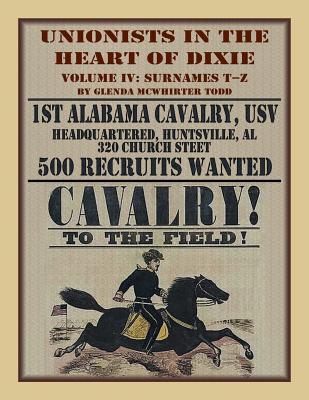This series of books includes the most extensive collection of records and information ever published on the 1st Alabama Cavalry, USV and its soldiers. The author has transcribed all of the military records, including muster rolls, on each of the soldiers, and in some cases, a transcription of pension records. Southern Claims are included on some of the soldiers. Each volume includes numerous pictures of some of the soldiers, as well as several Civil War sketches drawn by artist, Joe Harper, descendant of Private Joseph Harper. Unionists in the Heart of Dixie, Volume IV of this series of books includes the surnames of soldiers beginning with T through Z. Chapters include: William Lowndes Yancey Lashes Out at Unionists; Slaves in the Civil War including the 1st Alabama Cavalry, US Volunteers; A Black Civil War Veteran's Descendant Uncovers a Mystery; Fixing to Go to the Army; The Black Flag--Negro Soldiers Buried Alive; Colored Soldiers Who Served in the 1st Alabama Cavalry, US Volunteers, including Information and Pictures from Some Memorial Services Held; Camp Nelson, Kentucky, 1863-1866; Slavery during and after the Civil War, by Leslie H. Whitley; HDQRS. COMR. for Organization U.S. Colored Troops; Betrayal at Ebenezer Creek; Captured Confederate Prisoners at Gettysburg's 150th Anniversary, including Honoring William Alexander Nesmith, a 1st Alabama Cav., US Soldier; Unionists' Feeling in Alabama; Civil War Service of D. S. Purvine; Traveling Through the Icy Swamps on the March to the Sea; The Battle Cry of Freedom; Company Rosters, Names of Soldiers in Each Company; GAR, The Grand Army of the Republic and Kindred Societies; Civil War Military Hospitals in Nashville, Tennessee; Explanations of Some Records in Roster; Roster of Soldiers T-Z; Shhhhhhhhhhhh! Let's Not Talk About This, by Terry Thornton; Pension Records for Francis W. and Ella C. Tupper; and, Corrections and Additions from Volumes I, II, and III. Information on the following soldiers appears in this volume as it was submitted too late to be included in the earlier volumes: Jesse W. Austin, Levi G. Ballard, William Beasley, Sylvester Berry, Dillard "Dillon" Blevins, John Blevins, Ozias D. Boling, Charles W. Botkin, Isaac V. Bowman, Lorenzo Dow Bowman, Robert Alexander Boyd, Samuel Bradley, J.C. Brice, Fernando "Frank" Cortez Burdick, Berry Burns, William Jasper Butler, Reuben Cantrell, Jonathan W. Clark, Zion B. Cornelius, William J. Dean, Jeremiah Franklin Files, Andrew Pink Flanagin, John Gallion, George Lucious Godfrey, William Carroll "Buck" Buttery, Nathaniel Hale, John Madison Hallmark, Charles Hill Harbison, William White Harris, Jonathan Harris Hendon, Robert H. Hendon, David C. Herron, George S. Hughes, James J. Ingram, Jeremiah L. P. Jones, Thomas Jefferson Lockhart, John Michael Lunsford, and William Stewart. The questions most often asked of the author have been: "Who were these men? Why did they fight for the Union? What happened to them during and after the war?" The author has attempted to answer these questions; however, it is not known when some of the soldiers later died.

Unionists in the Heart of Dixie: 1st Alabama Cavalry, USV, Volume IV
This series of books includes the most extensive collection of records and information ever published on the 1st Alabama Cavalry, USV and its soldiers. The author has transcribed all of the military records, including muster rolls, on each of the soldiers, and in some cases, a transcription of pension records. Southern Claims are included on some of the soldiers. Each volume includes numerous pictures of some of the soldiers, as well as several Civil War sketches drawn by artist, Joe Harper, descendant of Private Joseph Harper. Unionists in the Heart of Dixie, Volume IV of this series of books includes the surnames of soldiers beginning with T through Z. Chapters include: William Lowndes Yancey Lashes Out at Unionists; Slaves in the Civil War including the 1st Alabama Cavalry, US Volunteers; A Black Civil War Veteran's Descendant Uncovers a Mystery; Fixing to Go to the Army; The Black Flag--Negro Soldiers Buried Alive; Colored Soldiers Who Served in the 1st Alabama Cavalry, US Volunteers, including Information and Pictures from Some Memorial Services Held; Camp Nelson, Kentucky, 1863-1866; Slavery during and after the Civil War, by Leslie H. Whitley; HDQRS. COMR. for Organization U.S. Colored Troops; Betrayal at Ebenezer Creek; Captured Confederate Prisoners at Gettysburg's 150th Anniversary, including Honoring William Alexander Nesmith, a 1st Alabama Cav., US Soldier; Unionists' Feeling in Alabama; Civil War Service of D. S. Purvine; Traveling Through the Icy Swamps on the March to the Sea; The Battle Cry of Freedom; Company Rosters, Names of Soldiers in Each Company; GAR, The Grand Army of the Republic and Kindred Societies; Civil War Military Hospitals in Nashville, Tennessee; Explanations of Some Records in Roster; Roster of Soldiers T-Z; Shhhhhhhhhhhh! Let's Not Talk About This, by Terry Thornton; Pension Records for Francis W. and Ella C. Tupper; and, Corrections and Additions from Volumes I, II, and III. Information on the following soldiers appears in this volume as it was submitted too late to be included in the earlier volumes: Jesse W. Austin, Levi G. Ballard, William Beasley, Sylvester Berry, Dillard "Dillon" Blevins, John Blevins, Ozias D. Boling, Charles W. Botkin, Isaac V. Bowman, Lorenzo Dow Bowman, Robert Alexander Boyd, Samuel Bradley, J.C. Brice, Fernando "Frank" Cortez Burdick, Berry Burns, William Jasper Butler, Reuben Cantrell, Jonathan W. Clark, Zion B. Cornelius, William J. Dean, Jeremiah Franklin Files, Andrew Pink Flanagin, John Gallion, George Lucious Godfrey, William Carroll "Buck" Buttery, Nathaniel Hale, John Madison Hallmark, Charles Hill Harbison, William White Harris, Jonathan Harris Hendon, Robert H. Hendon, David C. Herron, George S. Hughes, James J. Ingram, Jeremiah L. P. Jones, Thomas Jefferson Lockhart, John Michael Lunsford, and William Stewart. The questions most often asked of the author have been: "Who were these men? Why did they fight for the Union? What happened to them during and after the war?" The author has attempted to answer these questions; however, it is not known when some of the soldiers later died.